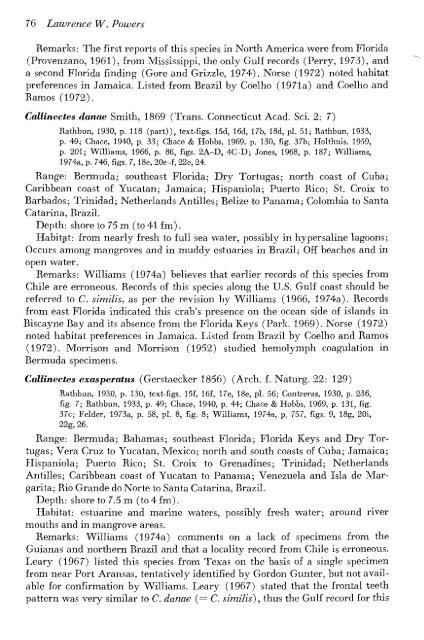Create successful ePaper yourself
Turn your PDF publications into a flip-book with our unique Google optimized e-Paper software.
76 Lawrence W. Powers<br />
Remarks: The first reports of this species in North America were from Florida<br />
(Provenzano, 1961), from Mississippi, the only Gulf records (Perry, 1973), and<br />
a second Florida finding (Gore and Grizzle, 1974). Norse (1972) noted habitat<br />
preferences in Jamaica. Listed from Brazil by Coelho (1971a) and Coelho and<br />
Ramos (1972).<br />
Callinectes danae Smith, 1869 (Trans. Connecticut Acad. Sci. 2: 7)<br />
Rathbun, 1930, p. 118 (part)), text-figs. 15d, 16d, 17b, 18d, pi. SI; Rathbun, 1933,<br />
p. 49; Chace, 1940, p. 33; Chace & Hobbs, 1969, p. 130, fig. 37b; Holthuis, 1959,<br />
p. 201; Williams, 1966, p. 86, figs. 2A-D, 4C-D; Jones, 1968, p. 187; Williams,<br />
1974a, p. 746, figs. 7,18e, 20e-f, 22e, 24.<br />
Range: Bermuda; southeast Florida; Dry Tortugas; north coast of Cuba;<br />
Caribbean coast of Yucatan; Jamaica; Hispaniola; Puerto Rico; St. Croix to<br />
Barbados; Trinidad; Netherlands Antilles; Belize to Panama; Colombia to Santa<br />
Catarina, Brazil.<br />
Depth: shore to 75 m (to 41 fm).<br />
Habitat: from nearly fresh to full sea water, possibty in hypersaline lagoons;<br />
Occurs among mangroves and in mudd}'- estuaries in Brazil; Off beaches and in<br />
open water.<br />
Remarks: Williams (1974a) believes that earlier records of this species from<br />
Chile are erroneous. Records of this species along the U.S. Gulf coast should be<br />
referred to C. similis, as per the revision by Williams (1966, 1974a). Records<br />
from east Florida indicated this crab's presence on the ocean side of islands in<br />
Biscayne Bay and its absence from the Florida Keys (Park, 1969). Norse (1972)<br />
noted habitat preferences in Jamaica. Listed from Brazil b}^ Coelho and Ramos<br />
(1972). Morrison and Morrison (1952) studied hemolymph coagulation in<br />
Bermuda specimens.<br />
Callinectes exasperatus (Gerstaecker 1856) (Arch. f. Naturg. 22: 129)<br />
Rathbun, 1930, p. 130, text-figs. I5f, 16f, 17e, 18e, pi. 56; Conti-eras, 1930, p. 236,<br />
fig. 7; Rathbun, 1933, p. 49; Chace, 1940, p. 4-1.; Chace & Hobbs, 1969, p. 131, fig.<br />
37c; Felder, 1973a, p. 58, pi. 8, fig. 8; Williams, 1974a, p. 757, figs. 9, 18g, 20i,<br />
22g, 26.<br />
Range: Bermuda; Bahamas; southeast Florida; Florida Keys and Dr};- Tortugas;<br />
Vera C^uz to Yucatan, Mexico; north and south coasts of Cuba; Jamaica;<br />
Hispaniola; Puerto Rico; St. Croix to Grenadines; Trinidad; Netherlands<br />
Antilles; Caribbean coast of Yucatan to Panama; Venezuela and Isla de Margarita;<br />
Rio Grande do Norte to Santa Catarina, Brazil.<br />
Depth: shore to 7.5 m (to 4 fm).<br />
Habitat: estuarine and marine waters, possibl}^ fresh water; around river<br />
mouths and in mangrove areas.<br />
Remarks: Williams (1974a) comments on a lack of specimens from the<br />
Guianas and northern Brazil and that a locality record from Chile is erroneous.<br />
Leary (1967) listed this species from Texas on the basis of a single specimen<br />
from near Port Aransas, tentatively identified by Gordon Gunter, but not available<br />
for confirmation by Williams. Leary (1967) stated that the frontal teeth<br />
pattern was very similar to C. danae (= C. similis), thus the Gulf record for this

















